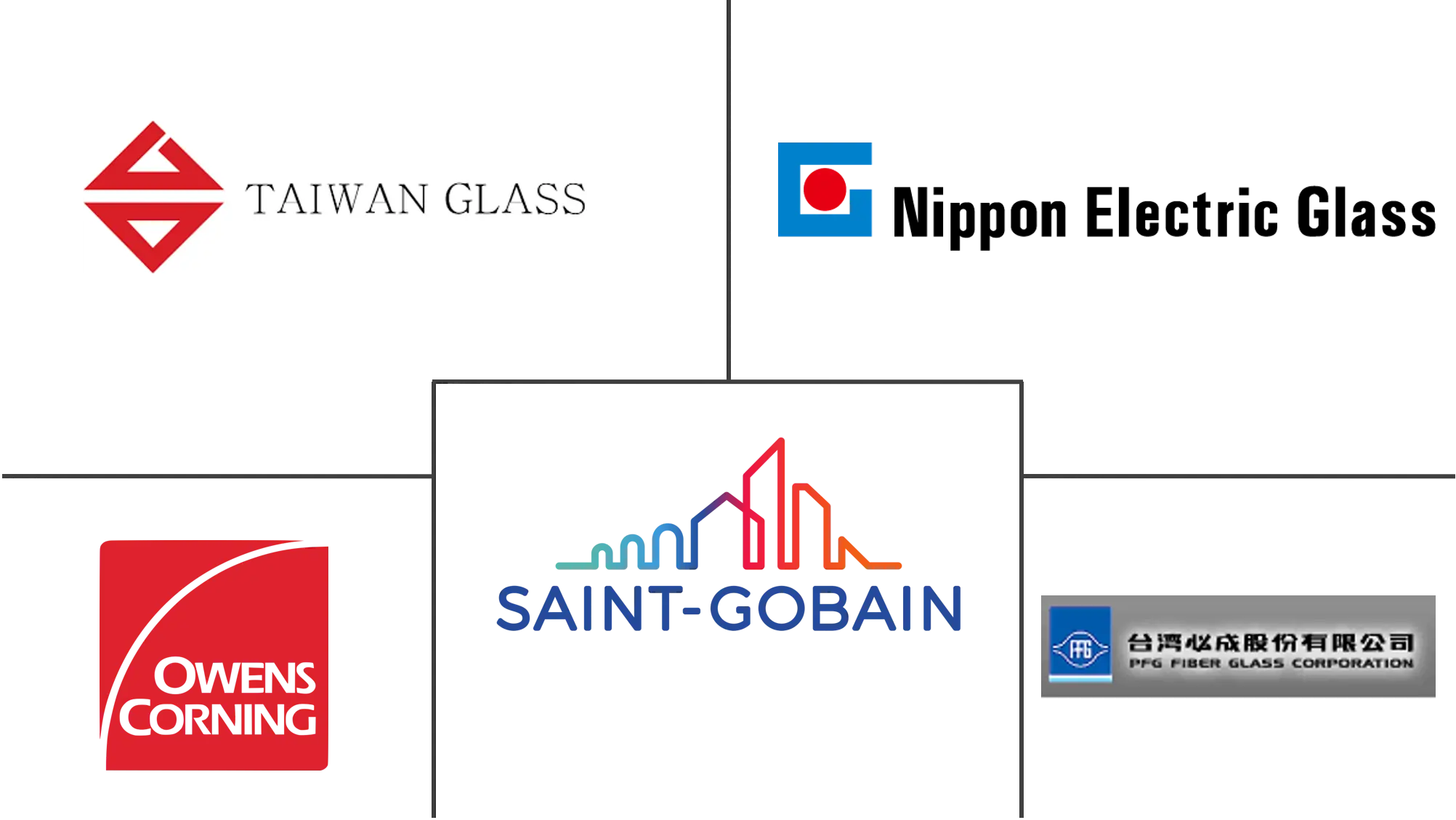Fiberglass Roving Market Size and Share
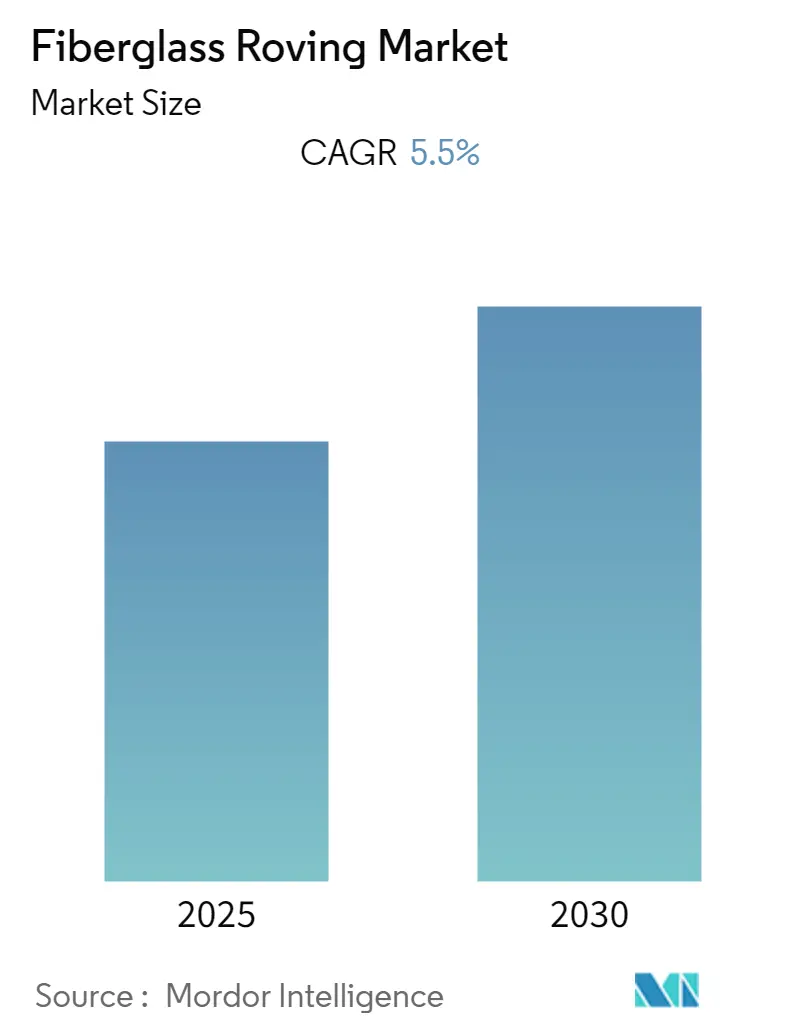
Fiberglass Roving Market Analysis by Mordor Intelligence
The Fiberglass Roving Market is expected to register a CAGR of 5.5% during the forecast period.
- The fiberglass roving that is made with E-glass is cost-efficient and also offers multiple properties such as lightweight, corrosion resistance, high electrical insulation, and strength. The increasing demand from the transportation and electrical & electronics industries is also expected to drive the market.
- The fiberglass is considered to be the foundation of the composites industry. From multiple decades it is being used in multiple composites applications, and its physical properties are also pretty well understood in the industry. Apart from being lightweight, it has moderate tensile strength and is easier to handle. Fiberglass has been used in a wide range of projects.
- The glass filament offers a greater specific resistance as compared to steel. This characteristic is one of the primary reason for the increasing demand for glass strand in the production of high-performance composites. Glass filament is also being used in a wide variety of applications owing to its properties such as electrical insulation, even at low thickness, combined with its mechanical strength and behavior in different temperatures.
- Moreover, owing to the recent coronavirus outbreak, manufacturing operations have been hit significantly in the industry due to the nationwide lockdown in multiple regions. However, as the units are starting their operations, vendors in the market are contributing to this virus outbreak. For instance, in Apr 2020, the Johns Manville plant in Richland, Mississippi, started producing non-woven filtration media that will be used to create the much-needed face masks to help stop the spread of COVID-19.
Global Fiberglass Roving Market Trends and Insights
Construction & Infrastructure is Expected to Witness Significant Growth
- The construction and infrastructure industry is one of the prominent end-user of fiberglass roving products and is expected to grow significantly throughout the forecast period. This is primarily owing to the increased construction projects in multiple regions across the world.
- The rapid urbanization is resulting in the increased development of infrastructure, thereby resulting in increased demand for fiberglass roving. The development of smart cities in countries, such as India and China, is also expected to further boost the need for these products.
- The trend of the growing population (According to the US Census Bureau, the population rose from 327 million in 2017 to 329 million in 2019) also contributes to the growth of the construction industry in the United States, and thus, the market for fiberglass roving.
- The construction sector is also expected to fortify to a much stronger extent, with new governmental regulations and initiatives. For instance, the Trump administration has introduced a plan to spend over USD 1 trillion in the construction sector, in 2018, led mostly by private businesses.
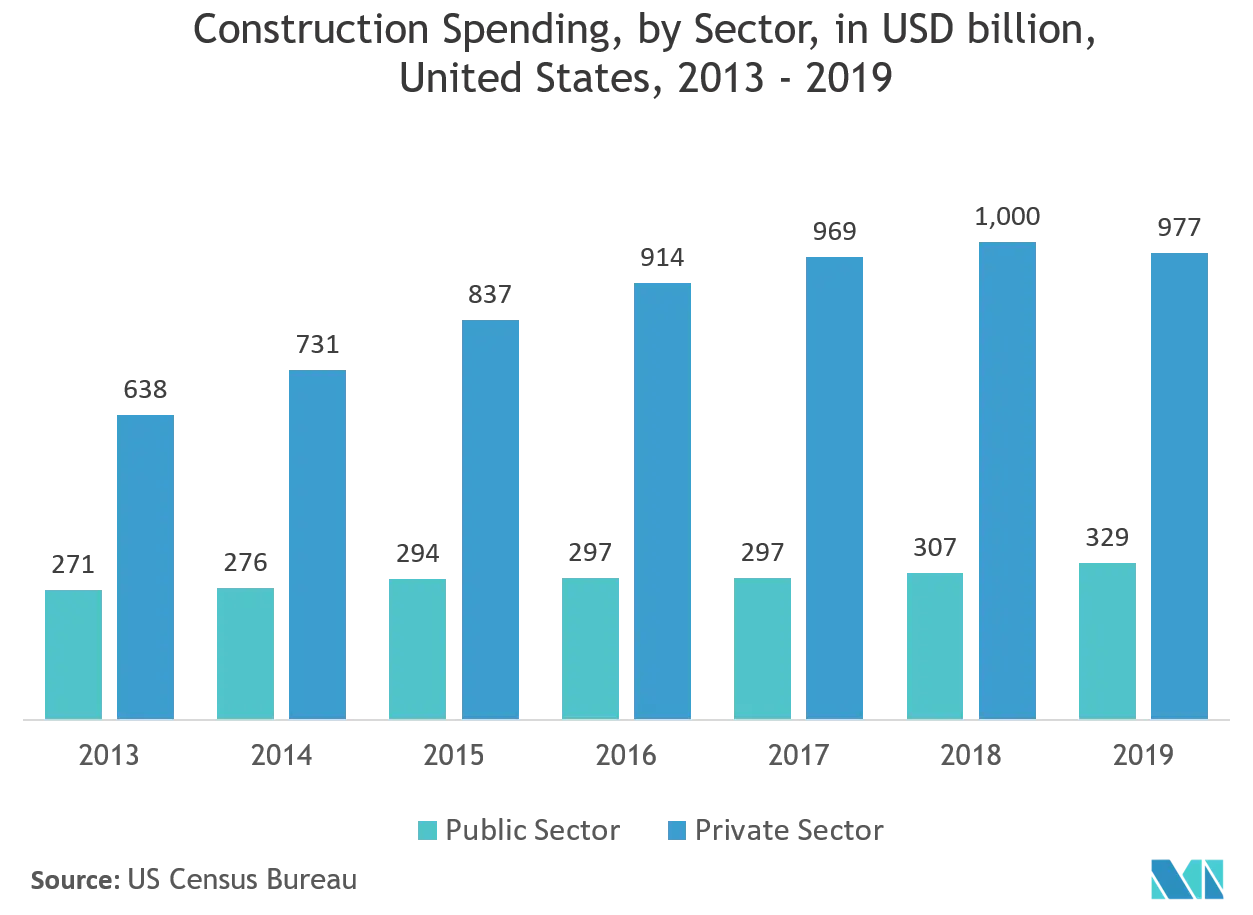
Asia Pacific is Expected to Witness Significant Growth
- The Asia-Pacific is one of the largest consumers of fiberglass roving. Multiple economies in the region, such as China, India, and Japan, are the major fiberglass roving markets in the region, primarily owing to the increasing wind energy projects, increasing construction and infrastructural activities.
- The fiberglass roving market in the region is also anticipated to register a significant growth rate during the forecast period, primarily owing to the rapidly increasing demand for environmentally-friendly products as well as new and stringent emission control policies that are significantly contributing toward the market growth.
- The region is also set to witness construction and infrastructure boom in the coming years with a healthy spread of projects that will be shared between residential, industrial, and infrastructural categories, which is also boosting the demand for fiberglass roving products, thereby driving the market. Moreover, the high rate of automotive production in countries like China and Japan are also resulting in the extensive use of fiberglass roving products in the region.
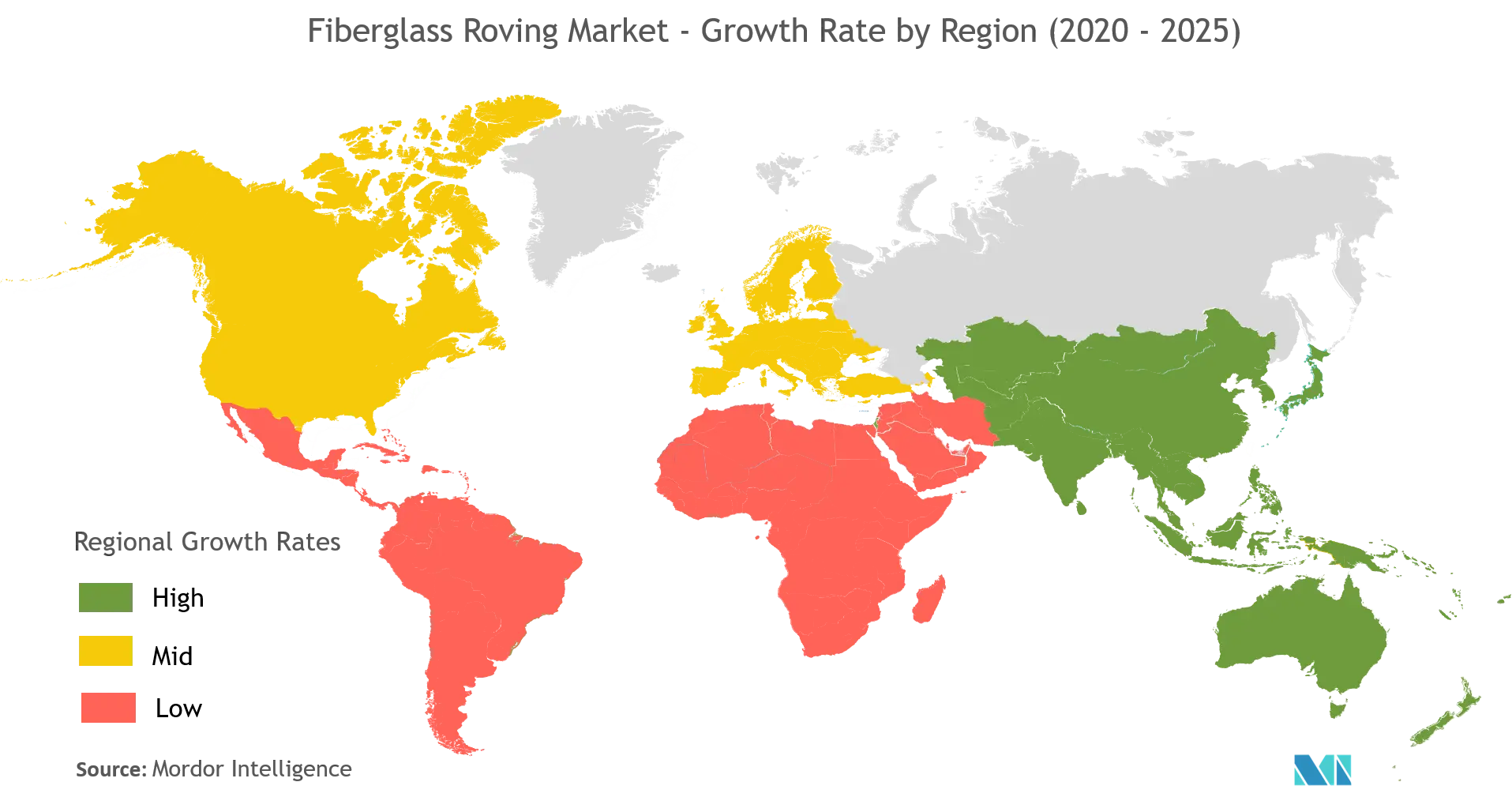
Competitive Landscape
The fiberglass roving market is highly competitive, owing to the presence of multiple players operating in domestic and international markets. The market appears to be moderately concentrated, with the key players adopting strategies such as product acquisition and mergers and acquisitions in order to widen their product portfolio and expand their geographic reach and stay competitive in the market. Some of the major players in the market are Owens Corning, Nippon Electric Glass, and Saint-Gobain SA.
- Jan 2020 - The Saint-Gobain fiberglass production furnace has undergone a complete overhaul. This is a largescale investment form the company in both financial and human terms. The rebuilding of the fiberglass production furnace was held at the company's ADFORS's Hodonice site. In terms of the amount, the investment was about EUR 45 million.
- Aug 2019 - Johns Manville, a Berkshire Hathaway company and a building products manufacturer, announced that its fiberglass batt and narrow roll insulation products received the NAIMA R-Value certification, offering third-party verification of the company's thermal performance.
Fiberglass Roving Industry Leaders
Owens Corning
Nippon Electric Glass
Saint-Gobain S.A.
Taiwan Glass Industry Corporation
PFG Fiberglass Corporation
- *Disclaimer: Major Players sorted in no particular order
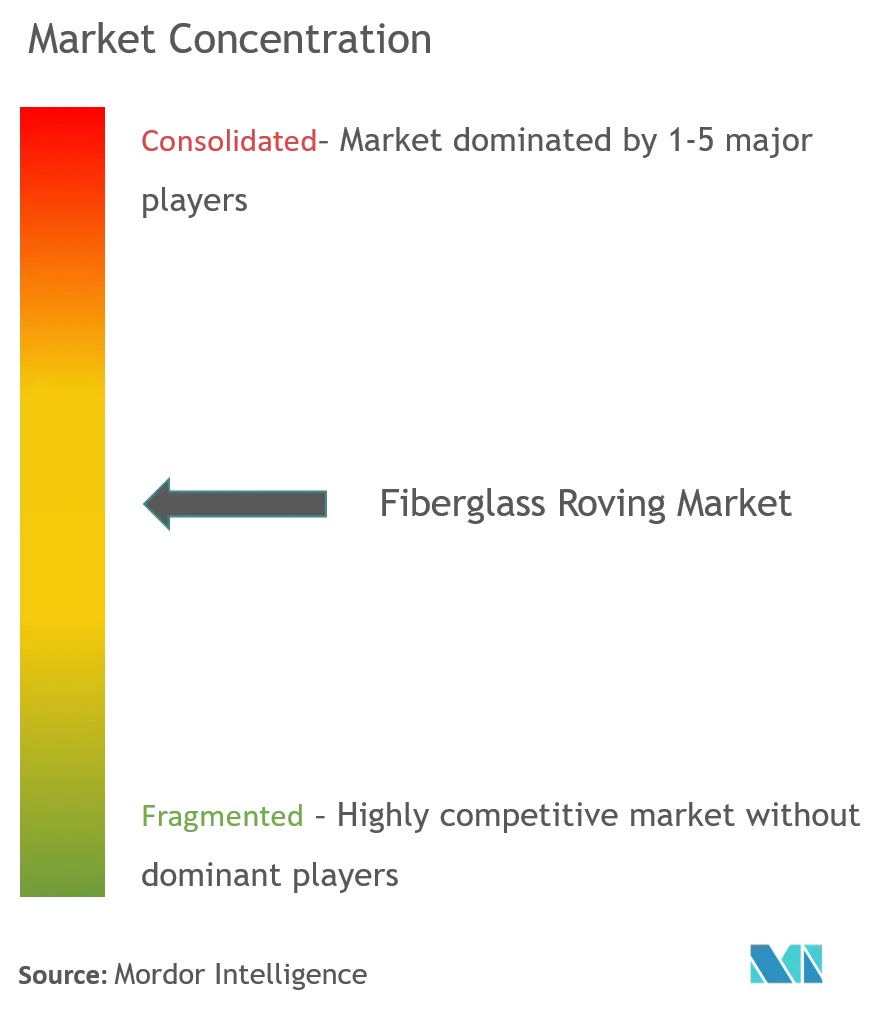
Global Fiberglass Roving Market Report Scope
The fiberglass roving product is made up of hundreds of tiny glass filaments. The roving is being reinforced with a chemical bonding material to create a protected cohesive strand. The term roving primarily refers to the actual process of bundling such materials together or the finished roll of strands.
| E-glass |
| H-glass |
| ECR-glass |
| S-glass |
| Other Types |
| Construction and Infrastructure |
| Transportation |
| Electrical and Electronics |
| Pipes and Tanks |
| Energy |
| Other End-user Industries |
| North America | United States |
| Canada | |
| Europe | United Kingdom |
| Germany | |
| France | |
| Rest of Europe | |
| Asia-Pacific | China |
| India | |
| Japan | |
| Rest of Asia-Pacific | |
| Latin America | |
| Middle East & Africa |
| By Type | E-glass | |
| H-glass | ||
| ECR-glass | ||
| S-glass | ||
| Other Types | ||
| By End-user Industry | Construction and Infrastructure | |
| Transportation | ||
| Electrical and Electronics | ||
| Pipes and Tanks | ||
| Energy | ||
| Other End-user Industries | ||
| Geography | North America | United States |
| Canada | ||
| Europe | United Kingdom | |
| Germany | ||
| France | ||
| Rest of Europe | ||
| Asia-Pacific | China | |
| India | ||
| Japan | ||
| Rest of Asia-Pacific | ||
| Latin America | ||
| Middle East & Africa | ||
Key Questions Answered in the Report
What is the current Fiberglass Roving Market size?
The Fiberglass Roving Market is projected to register a CAGR of 5.5% during the forecast period (2025-2030)
Who are the key players in Fiberglass Roving Market?
Owens Corning, Nippon Electric Glass, Saint-Gobain S.A., Taiwan Glass Industry Corporation and PFG Fiberglass Corporation are the major companies operating in the Fiberglass Roving Market.
Which is the fastest growing region in Fiberglass Roving Market?
Asia Pacific is estimated to grow at the highest CAGR over the forecast period (2025-2030).
Which region has the biggest share in Fiberglass Roving Market?
In 2025, the North America accounts for the largest market share in Fiberglass Roving Market.
What years does this Fiberglass Roving Market cover?
The report covers the Fiberglass Roving Market historical market size for years: 2019, 2020, 2021, 2022, 2023 and 2024. The report also forecasts the Fiberglass Roving Market size for years: 2025, 2026, 2027, 2028, 2029 and 2030.
Page last updated on:
Fiberglass Roving Market Report
Statistics for the 2025 Fiberglass Roving market share, size and revenue growth rate, created by Mordor Intelligence™ Industry Reports. Fiberglass Roving analysis includes a market forecast outlook for 2025 to 2030 and historical overview. Get a sample of this industry analysis as a free report PDF download.
